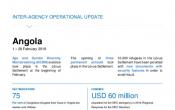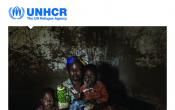Angola
Operation: Angola
Location
{"longitude":18,"latitude":-12,"zoom_level":0,"iso_codes":"'AGO'"}
By clicking on the icons on the map, additional information is displayed.
The boundaries and names shown and the designations used on this map do not imply official endorsement or acceptance by the United Nations.
Key Figures
| 2019 year-end results | |
| 3,400 | refugee children, out of a target of 4,500, were enrolled in primary education in the Lóvua settlement and were fully included in the national education system |
| 860 | people were referred to secondary and tertiary medical care in the Lóvua settlement, which represented 86% of the target of 1,000 |
| 200 | new admissions were made to supplementary feeding programmes in the Lóvua settlement, from a total of 1,335 (90%) of children under-five screened for malnutrition |
| 20 | litres of potable water were available per person per day on average in the Lóvua settlement |
| 3 | new educational facilities were constructed in the Lóvua settlement |
| 2020 planning figures | |
| 1,500 | people of concern receiving life-skills training for livelihood purposes |
| 20 | litres of potable water available per person per day |
| 100% | of return has been voluntary, and in safety and dignity |
| 100% | people of concern provided with individual protection documentation |
| 80% | of primary school-aged children enrolled in primary education |
People of Concern
20%
Decrease in
2019
2019
| 2019 | 56,056 |
| 2018 | 70,005 |
| 2017 | 71,270 |

[["Refugees",25802],["Asylum-seekers",30192],["Others of concern",62]]
Loading ...
Angola
< Back
2019
{"categories":[2015,2016,2017,2018,2019,2020],"budget":[5.453056360000001,3.72148992,36.642183270000004,31.01241581,23.20689238,22.5997044],"expenditure":[3.08539954,2.06958952,19.44200489,16.9504877,12.75126857,null]}
{"categories":[2015,2016,2017,2018,2019,2020],"p1":[5.453056360000001,3.72148992,36.642183270000004,31.01241581,23.20689238,22.4797044],"p2":[null,null,null,null,null,0.12],"p3":[null,null,null,null,null,null],"p4":[null,null,null,null,null,null]}
{"categories":[2015,2016,2017,2018,2019,2020],"p1":[3.08539954,2.06958952,19.44200489,16.9504877,12.75126857,null],"p2":[null,null,null,null,null,null],"p3":[null,null,null,null,null,null],"p4":[null,null,null,null,null,null]}
Loading ...
CHOOSE A YEAR
- 2015
- 2016
- 2017
- 2018
- 2019
- 2020
Operational context
As a result of violence in the Kasai region of the Democratic Republic of the Congo (DRC) in 2017, over 35,000 refugees sought safety in Lunda Norte Province, Angola. However, after the presidential elections in the DRC in early 2019, a group of refugees approached UNHCR and expressed their wish to return to their country of origin.Following a tripartite agreement between UNHCR and the Governments of Angola and the DRC in October, UNHCR facilitated a voluntary repatriation exercise that resulted in the return of nearly 2,600 refugees to the Kasai region in the DRC. A further 14,800 refugees also returned to the DRC of their own accord. Some 3,000 Congolese refugees remained in the urban areas of Dundo and 6,400 in the Lóvua settlement in the Lunda Norte Province, the only refugee settlement in Angola.
It was also estimated that there were some 38,000 asylum-seekers in and around the capital, Luanda. The urban refugee population in Luanda continued to face challenges due to lack of registration and documentation, after the Government stopped the registration of refugees at the end of 2018. UNHCR continued to advocate with the Government for resumption of refugee status determination (RSD), as well as for a registration/verification exercise to be organized. During the Global Refugee Forum in December 2019, the Government pledged to improve the protection of refugees and asylum-seekers in Angola through the regular functioning of the CNR (National Council for Refugees).
Population trends
The year started with some 70,060 people of concern to UNHCR, including some 39,870 refugees and 30,140 asylum-seekers. By end of the year however, the population figures significantly dropped, particularly as a result of political changes in the DRC, Kasai Province, that led to self-organized as well as organized return to the DRC.Achievements
In 2019 the Government acceded to both statelessness conventions.
Unmet needs
- In the Lóvua settlement, there was insufficient funding to provide secondary education and professional opportunities for refugees.
- Lack of agricultural projects in Lóvua settlement due to insufficient funding undermined access to a varied nutritional diet and to other sources of income.
- The suspension of registration and RSD continued to impact the lives and well-being of people of concern. New arrivals remained unregistered for many years, while those who were registered before held expired documents.
Operational Environment
The political and economic environment in Angola is expected to remain stable, while the operational context will be characterized by the evolution of events in neighbouring countries, in particular in the Democratic Republic of the Congo (DRC). The situation remains volatile in the Kasai region of the DRC with rising numbers of internally displaced people. The Government of Angola maintains an open door policy to Congolese fleeing the hostilities.Approximately 15,000 refugees and 30,000 asylum-seekers reside in the Luanda, Huambo, Bengo, Zaire, and Uige provinces of Angola. Furthermore, the outbreak of violence in the Kasai region of the DRC in March 2017 triggered the displacement of over 35,000 refugees into Lunda Norte Province. In September 2018, some 22,500 biometrically registered refugees were receiving food and other assistance in Lóvua settlement and host communities.
The asylum law, which entered into force in June 2015, foresees the creation of a new refugee status determination body and the introduction of a judicial appeal as second instance. On 25 July 2018, regulations for the establishment of refugee reception centres (CARRA) and a national refugee commission (CNR), with UNHCR as an observer, were approved.
The Government has requested UNHCR’s support to re-initiate the registration of refugees in areas outside Lunda Norte Province.
Furthermore, the Government is planning to start the verification and biometrical re-registration of 15,000 refugees and 30,000 asylum-seekers in Bengo, Huambo, Luanda, Uige and Zaire provinces in December 2018. This exercise is expected to continue in 2019.
UNHCR’s main governmental partners in Angola are the Ministries of Foreign Affairs, Interior including the Service for Migration and Foreigners as well as Social Action, Women’s Rights and Family in national and provincial level. UNHCR also works closely with other UN agencies and civil society organizations.
Following the refugee influx from the DRC in 2017, Angola is considering the rolling out of the Comprehensive Refugee Response Framework (CRRF). The United Nations Development Assistance Framework (UNDAF) process is already contributing to the implementation of CRRF methodology as it enhances the engagement of development actors to achieve solutions for refugees and asylum-seekers.
Key Priorities
UNHCR will continue to support the Government of Angola at central, provincial and local levels in the protection and assistance of refugees and asylum-seekers. Priority areas will be implemented through strategic partnerships with the global and regional development institutions and other UN agencies. UNHCR will also pursue to strengthen the engagement of civil society in refugee protection as well as to improve the public perception towards people of concern.In 2019, UNHCR will focus on:
- pursuing to re-establish refugee status determination procedures and improve registration mechanisms, in close coordination with the Government and partners;
- providing protection and humanitarian assistance to Congolese refugees in Lunda Norte Province; and
- maintaining the emergency response capacity to respond any further influx of Congolese refugees.















